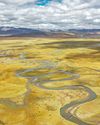
In Asia, seahorses are generally bought by men over the age of 50. Blended with herbs and boiled as a tea, they’re most often used to treat male sexual dysfunction, though they’re also said to relieve a broad range of ailments, including skin conditions, asthma, lethargy and menstrual cramps. That, of course, is according to traditional Chinese medicine (TCM), but it goes without saying that there’s no scientific evidence to support the idea that ingesting seahorse boosts performance, improves your complexion or helps you breathe more easily.
Chinese medicine shops across the region are crammed with seahorses, selling for a few US dollars each. Large, pale and smooth-skinned seahorses tend to fetch higher prices, making species like the yellow seahorse extremely valuable to the TCM trade. Also known as the common seahorse, spotted seahorse, estuary seahorse and oceanic seahorse, Hippocampus kuda has no spines and is typically between 7 and 17 centimetres, on the large side for a seahorse. The body colouration is often yellow or yellowish, though it can also be brown or black, with numerous very fine dark spots.
The yellow seahorse could be called an Asian icon, as it inhabits waters from the Persian Gulf to Southeast Asia and the Pacific islands beyond, as far north as Japan and as far south as Australia. They are found in shallow waters of estuaries, lagoons, harbours, coastal zones, and seagrass beds. But experts say their numbers are dwindling. Their conservation status was first assessed nearly 30 years ago, with a 30-percent decline in numbers reported in 1989–99. They have appeared on the International Union for Conservation of Nature (IUCN) Red List of Threatened Species as “Vulnerable” since, though the last species assessment was more than a decade ago, and there’s an urgent need for updated information.
Denne historien er fra AG 164-utgaven av ASIAN Geographic.
Start din 7-dagers gratis prøveperiode på Magzter GOLD for å få tilgang til tusenvis av utvalgte premiumhistorier og 9000+ magasiner og aviser.
Allerede abonnent ? Logg på
Denne historien er fra AG 164-utgaven av ASIAN Geographic.
Start din 7-dagers gratis prøveperiode på Magzter GOLD for å få tilgang til tusenvis av utvalgte premiumhistorier og 9000+ magasiner og aviser.
Allerede abonnent? Logg på

A Spectrum Of Scarlet: The Symbolic Red Of Asian Flags
A common thread that unites many Asian flags is the prominent use of red, a colour rich with symbolism

Curry: A World of Flavour, Tradition, and Culture
From its humble beginnings in India, the concept of "curry" has evolved into a culinary language understood around the world

The Power Of Asian Red Fruits - Discover 10 Nutrient-Rich Gems Of The East
In the vast tapestry of Nature, Asia has gifted the world an array of unique and vibrant fruits, particularly those in shades of red. These scarlet-hued gems, packed with flavour and nutrients, not only add a burst of colour to your plate but also carry valuable health benefits. From antioxidant-rich goji berries to the exotic dragon fruit, let's explore some of the most popular red fruits from Asia and discover why they should be part of your diet.

Bhutan: A World Of Its Own
With its majestic monasteries, red-robed monks, charming rural villages, and vibrant festivals, the Kingdom of Bhutan is a Himalayan paradise that promises an enriching travel experience like no other

Take The Red Pill
From the vermilion torii gates of Japan to the famed rust-hued walls of India's Agra Fort, the burgundy robes of Burmese monks to scarlet chillies drying in the Bangladeshi sun, red is the quintessential colour of Asia.

70 Days for Our Land Animals
Raising awareness about conservation, the environment, and the land-dwelling species of the world

The Red Panda
Meet the elusive guardian of the Eastern Himalayas

Revealed Doctor Yellow
Japan Railways' special lemony Shinkansen is a rare sight to behold

The Mighty Yellow
Over 5,000 kilometres long and flowing through nine provinces and autonomous regions, the Yellow River is China's second largest, after the Yangtze, while its basin is deemed the cradle of Chinese civilisation

Wildlife Big Yellow Beauty
The popular "amelanistic" form of the Burmese python is considered among the most beautiful snakes - if that's your sort of thing